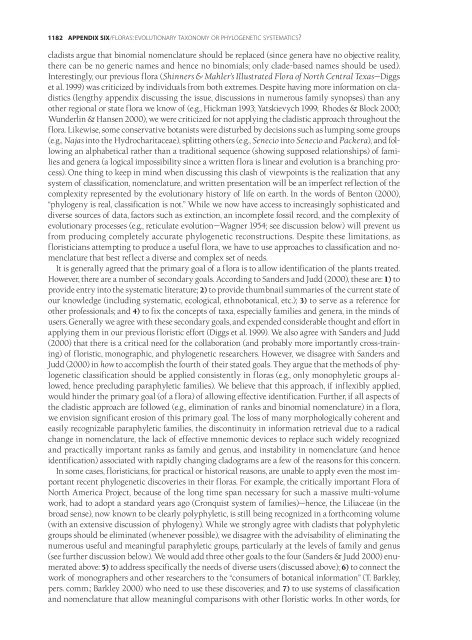Appendices & Glossary - Botanical Research Institute of Texas
Appendices & Glossary - Botanical Research Institute of Texas
Appendices & Glossary - Botanical Research Institute of Texas
Create successful ePaper yourself
Turn your PDF publications into a flip-book with our unique Google optimized e-Paper software.
1182 APPENDIX SIX/FLORAS: EVOLUTIONARY TAXONOMY OR PHYLOGENETIC SYSTEMATICS?<br />
cladists argue that binomial nomenclature should be replaced (since genera have no objective reality,<br />
there can be no generic names and hence no binomials; only clade-based names should be used).<br />
Interestingly, our previous flora (Shinners & Mahler’s Illustrated Flora <strong>of</strong> North Central <strong>Texas</strong>—Diggs<br />
et al. 1999) was criticized by individuals from both extremes. Despite having more information on cladistics<br />
(lengthy appendix discussing the issue, discussions in numerous family synopses) than any<br />
other regional or state flora we know <strong>of</strong> (e.g., Hickman 1993; Yatskievych 1999; Rhodes & Block 2000;<br />
Wunderlin & Hansen 2000), we were criticized for not applying the cladistic approach throughout the<br />
flora. Likewise, some conservative botanists were disturbed by decisions such as lumping some groups<br />
(e.g., Najas into the Hydrocharitaceae), splitting others (e.g., Senecio into Senecio and Packera), and following<br />
an alphabetical rather than a traditional sequence (showing supposed relationships) <strong>of</strong> families<br />
and genera (a logical impossibility since a written flora is linear and evolution is a branching process).<br />
One thing to keep in mind when discussing this clash <strong>of</strong> viewpoints is the realization that any<br />
system <strong>of</strong> classification, nomenclature, and written presentation will be an imperfect reflection <strong>of</strong> the<br />
complexity represented by the evolutionary history <strong>of</strong> life on earth. In the words <strong>of</strong> Benton (2000),<br />
“phylogeny is real, classification is not.” While we now have access to increasingly sophisticated and<br />
diverse sources <strong>of</strong> data, factors such as extinction, an incomplete fossil record, and the complexity <strong>of</strong><br />
evolutionary processes (e.g., reticulate evolution—Wagner 1954; see discussion below) will prevent us<br />
from producing completely accurate phylogenetic reconstructions. Despite these limitations, as<br />
floristicians attempting to produce a useful flora, we have to use approaches to classification and nomenclature<br />
that best reflect a diverse and complex set <strong>of</strong> needs.<br />
It is generally agreed that the primary goal <strong>of</strong> a flora is to allow identification <strong>of</strong> the plants treated.<br />
However, there are a number <strong>of</strong> secondary goals. According to Sanders and Judd (2000), these are: 1) to<br />
provide entry into the systematic literature; 2) to provide thumbnail summaries <strong>of</strong> the current state <strong>of</strong><br />
our knowledge (including systematic, ecological, ethnobotanical, etc.); 3) to serve as a reference for<br />
other pr<strong>of</strong>essionals; and 4) to fix the concepts <strong>of</strong> taxa, especially families and genera, in the minds <strong>of</strong><br />
users. Generally we agree with these secondary goals, and expended considerable thought and effort in<br />
applying them in our previous floristic effort (Diggs et al. 1999). We also agree with Sanders and Judd<br />
(2000) that there is a critical need for the collaboration (and probably more importantly cross-training)<br />
<strong>of</strong> floristic, monographic, and phylogenetic researchers. However, we disagree with Sanders and<br />
Judd (2000) in how to accomplish the fourth <strong>of</strong> their stated goals. They argue that the methods <strong>of</strong> phylogenetic<br />
classification should be applied consistently in floras (e.g., only monophyletic groups allowed,<br />
hence precluding paraphyletic families). We believe that this approach, if inflexibly applied,<br />
would hinder the primary goal (<strong>of</strong> a flora) <strong>of</strong> allowing effective identification. Further, if all aspects <strong>of</strong><br />
the cladistic approach are followed (e.g., elimination <strong>of</strong> ranks and binomial nomenclature) in a flora,<br />
we envision significant erosion <strong>of</strong> this primary goal. The loss <strong>of</strong> many morphologically coherent and<br />
easily recognizable paraphyletic families, the discontinuity in information retrieval due to a radical<br />
change in nomenclature, the lack <strong>of</strong> effective mnemonic devices to replace such widely recognized<br />
and practically important ranks as family and genus, and instability in nomenclature (and hence<br />
identification) associated with rapidly changing cladograms are a few <strong>of</strong> the reasons for this concern.<br />
In some cases, floristicians, for practical or historical reasons, are unable to apply even the most important<br />
recent phylogenetic discoveries in their floras. For example, the critically important Flora <strong>of</strong><br />
North America Project, because <strong>of</strong> the long time span necessary for such a massive multi-volume<br />
work, had to adopt a standard years ago (Cronquist system <strong>of</strong> families)—hence, the Liliaceae (in the<br />
broad sense), now known to be clearly polyphyletic, is still being recognized in a forthcoming volume<br />
(with an extensive discussion <strong>of</strong> phylogeny). While we strongly agree with cladists that polyphyletic<br />
groups should be eliminated (whenever possible), we disagree with the advisability <strong>of</strong> eliminating the<br />
numerous useful and meaningful paraphyletic groups, particularly at the levels <strong>of</strong> family and genus<br />
(see further discussion below). We would add three other goals to the four (Sanders & Judd 2000) enumerated<br />
above: 5) to address specifically the needs <strong>of</strong> diverse users (discussed above); 6) to connect the<br />
work <strong>of</strong> monographers and other researchers to the “consumers <strong>of</strong> botanical information” (T. Barkley,<br />
pers. comm.; Barkley 2000) who need to use these discoveries; and 7) to use systems <strong>of</strong> classification<br />
and nomenclature that allow meaningful comparisons with other floristic works. In other words, for
















